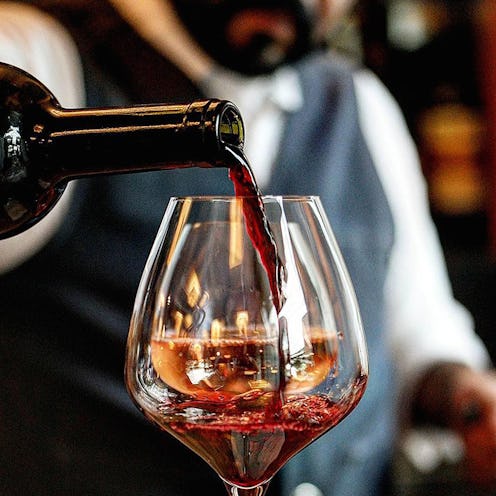When it comes to the most romantic night of the year, it’s not only important that you dress the part but also that you know what you’re talking about when the “wine guy” stops by your table at the restaurant or before you pour a glass of vino for that special dinner you’re hosting in your home. If you don’t speak wine fluently, don’t worry. To make sure you are equipped with a plethora of impressive knowledge, we went to sommelier Sean Haarberg of Trinitas Cellars in Napa Valley. We asked him for a cheat sheet on the must-know information when the goal is to impress your date. Read on and drink up.
Don't Underestimate The Importance Of Good Glassware
"Consider your wineglass an accessory to enhance the wine-drinking experience since a good quality glass is a surefire way to increase the enjoyment of sipping wine," says Haarberg. "Premium brands like Riedel feel, sound and look luxurious, especially when compared to mismatched hand-me-downs, and they can be purchased in pairs if you don't want to invest in a full set. Although there is a myriad of different styles and shapes of good glassware, a good starting point is to get yourself a set of Bordeaux-shaped glasses. These are perfect for cabs, merlots, malbec and cab franc. The other glass you should have in your set is the Burgundy shape. This glass has a bigger and wider bowl which lets more of the aromatics rise out, and the shape of the rim helps direct the wine flow to the zone of the tongue that perceives sweetness. The Burgundy glass is suited for pinot noir, chardonnay and sparkling rosé."
Drink Your Due Diligence
"If dining out, you can always call ahead and get a copy of the wine list—that way you can ask questions over the phone if you're intimidated to do so in person," says Haarberg. "Let them know what you will likely order, and they will be glad to recommend their favorites. If you get a copy of the wine list in advance, you can do a little research on your own to learn more and make an educated selection. You could also stop into your neighborhood wine shop or a bar days leading up to your date with a few friends to try some wines, have the experts teach you a few things and help you determine a good choice to match the style of restaurant or meal you're preparing."
Your Wine And Your Meal Don’t Have To Match.
"Red wine with red meat and white wine with seafood is usually a safe bet, but don't feel like you can't divert based on your preferences," says Haarberg. "For instance, a California chardonnay pairs well with a meat dish like a filet with Béarnaise sauce, and a nice pinot noir pairs well with grilled salmon. Also, wine bottles often list the types of food and flavors they go best with. So if you know what type of wine you like, check the back of the bottle to help you decide what to cook or where to dine out."
You can (and should) decant.
"Even inexpensive wines benefit tremendously from breathing a bit," says Haarberg. "It opens up the wine and allows the aromatics to be showcased at their fullest potential. If you don’t have a decanter at home, use a glass pitcher or similar (just make sure it's clean and doesn't smell like the margaritas you had in it last week). After pouring the wine into the pitcher, let it breathe for 30 to 40 minute while you get ready for your date, then either pour it back into the bottle or serve it directly from the decanter if you have one."
Consider BYOB.
"Almost all restaurants allow you to bring your own bottle of wine; however, they may have a corkage fee," says Haarberg. "If you already know what wine you like, and it is not on the restaurant's wine list, by all means bring your own. The standard markup for wine at a restaurant is 250 to 300 percent, so even if you are paying the corkage fee, it's not only a more economical choice, it allows you to enjoy a nicer bottle. I'd recommend that if you go this route to choose a decent bottle or one that has significance—whether it's your favorite varietal or is from the region where you studied abroad—which also makes it a nice conversation starter."
You Can Be A Sommelier, Too.
"Ever wonder how sommeliers have such amazing palates? I know I did before learning myself," says Haarberg. "If you want to build your wine-tasting skills, pay attention to smells or aromas around you. Whenever I am at the farmer's market, I constantly smell everything from fruits and vegetables to the fresh honey and various fruit preserves. I even breathe in the soils in the potted plants. I make a mental log in my head of all of these aromatics to build a database. When you have all of these scents fresh in your mind, the next time you nose a wine you will be amazed how complex it is. It will spur up those memories, causing you to seek out wines that have the nuances that you like. For example, this may sound odd, but I love big California cabs that have what I call a 'forest floor' and a mushroomy character in the nose. These cabs also have the typical black fruit and oak notes, but I try to focus more on the secondary notes, which is where all the complexity and personality of the wine lives."
